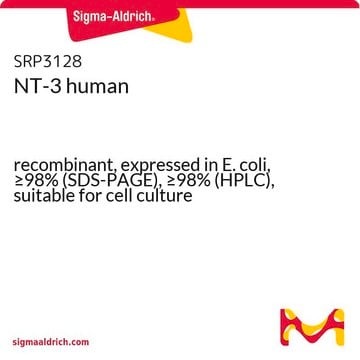C3710
Ciliary Neurotrophic Factor human
CNTF, recombinant, expressed in E. coli, lyophilized powder, suitable for cell culture
Synonim(y):
CNTF
About This Item
Polecane produkty
pochodzenie biologiczne
human
Poziom jakości
rekombinowane
expressed in E. coli
Próba
≥95% (SDS-PAGE)
Postać
lyophilized powder
siła działania
≤325 ng/mL ED50 ((≥ 3.1 x 103 units/mg))
jakość
endotoxin tested
masa cząsteczkowa
22.8 kDa
opakowanie
pkg of 10 and 20 μg
warunki przechowywania
avoid repeated freeze/thaw cycles
metody
cell culture | mammalian: suitable
zanieczyszczenia
≤10 EU/μg
numer dostępu UniProt
temp. przechowywania
−20°C
informacje o genach
human ... CNTF(1270) , CNTF (1270)
Powiązane kategorie
Opis ogólny
Zastosowanie
Działania biochem./fizjol.
Postać fizyczna
Komentarz do analizy
Kod klasy składowania
13 - Non Combustible Solids
Klasa zagrożenia wodnego (WGK)
WGK 3
Temperatura zapłonu (°F)
Not applicable
Temperatura zapłonu (°C)
Not applicable
Środki ochrony indywidualnej
Eyeshields, Gloves, type N95 (US)
Certyfikaty analizy (CoA)
Poszukaj Certyfikaty analizy (CoA), wpisując numer partii/serii produktów. Numery serii i partii można znaleźć na etykiecie produktu po słowach „seria” lub „partia”.
Masz już ten produkt?
Dokumenty związane z niedawno zakupionymi produktami zostały zamieszczone w Bibliotece dokumentów.
Klienci oglądali również te produkty
Nasz zespół naukowców ma doświadczenie we wszystkich obszarach badań, w tym w naukach przyrodniczych, materiałoznawstwie, syntezie chemicznej, chromatografii, analityce i wielu innych dziedzinach.
Skontaktuj się z zespołem ds. pomocy technicznej











